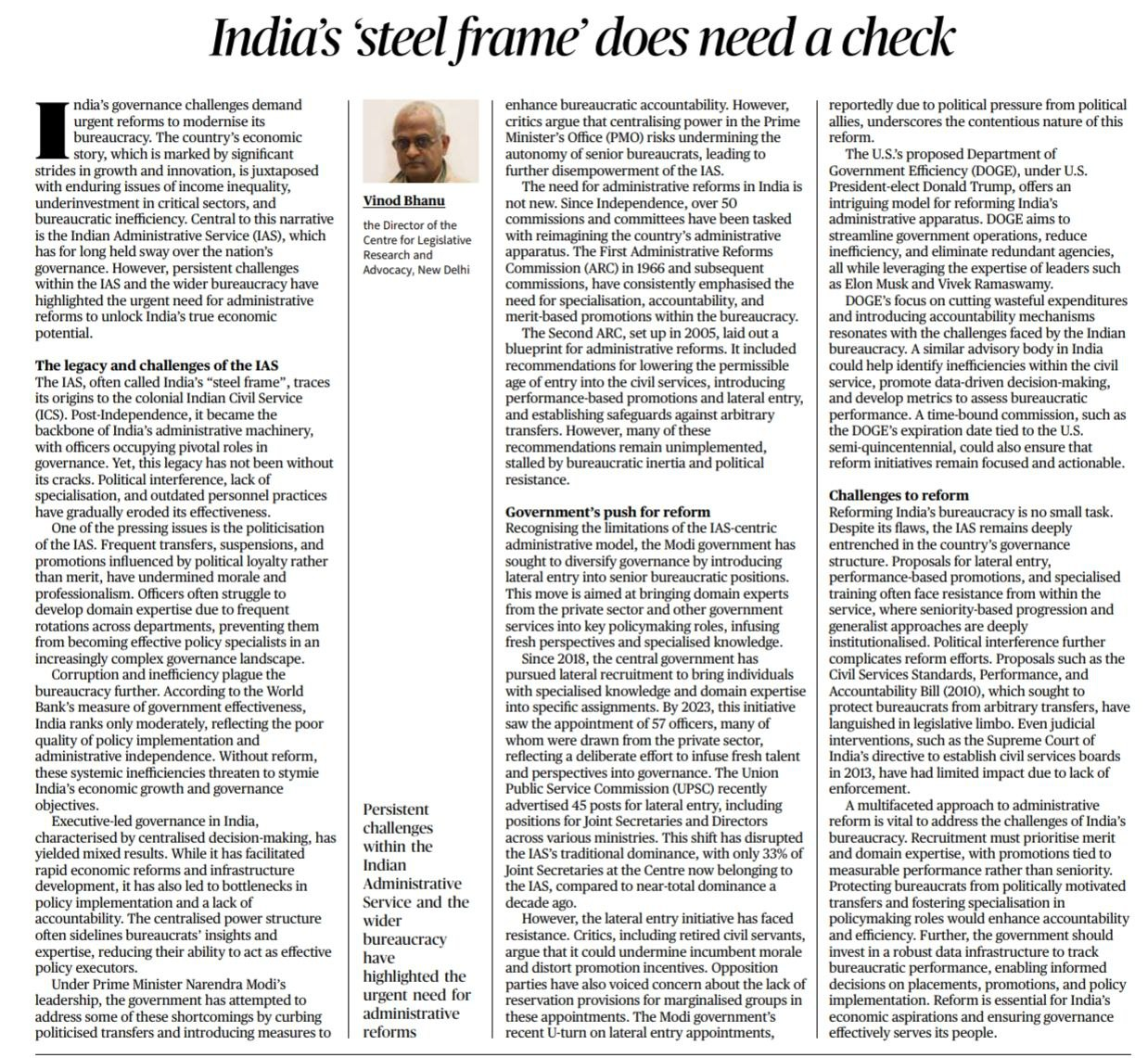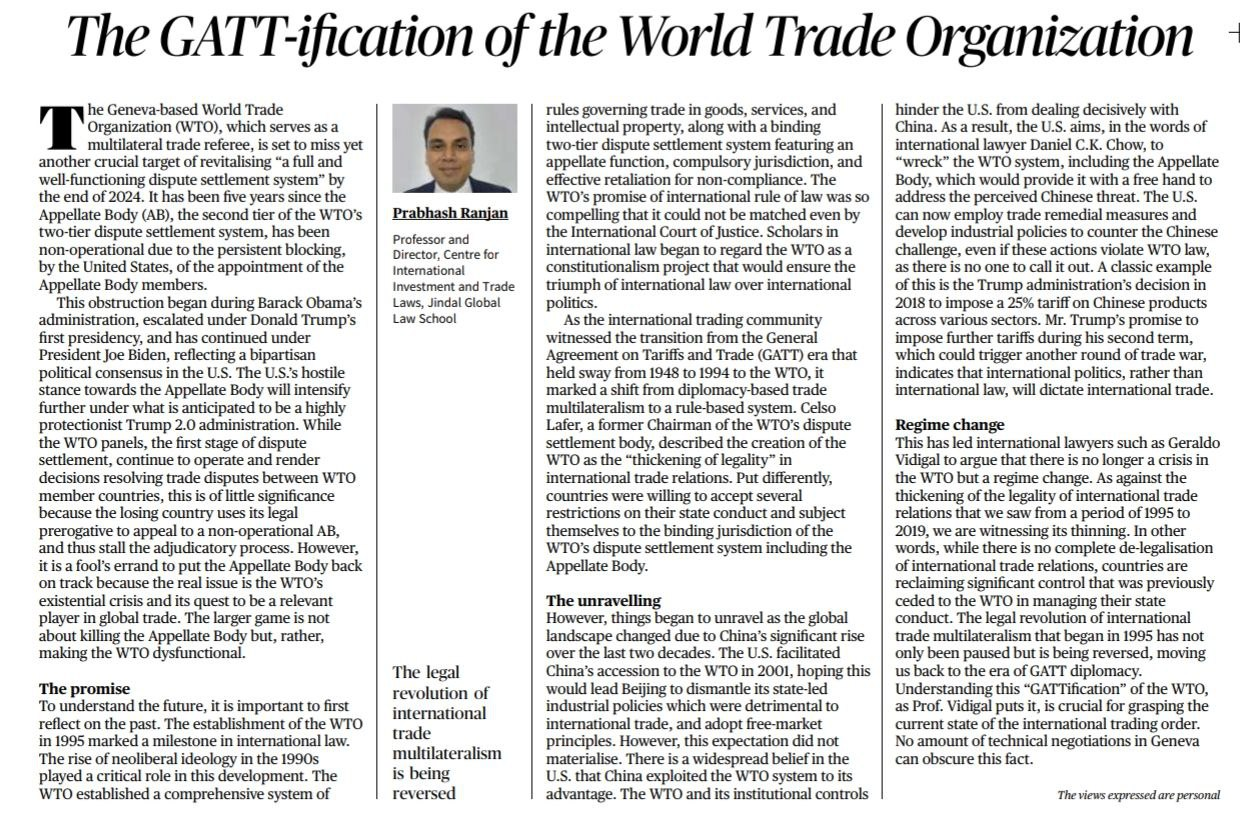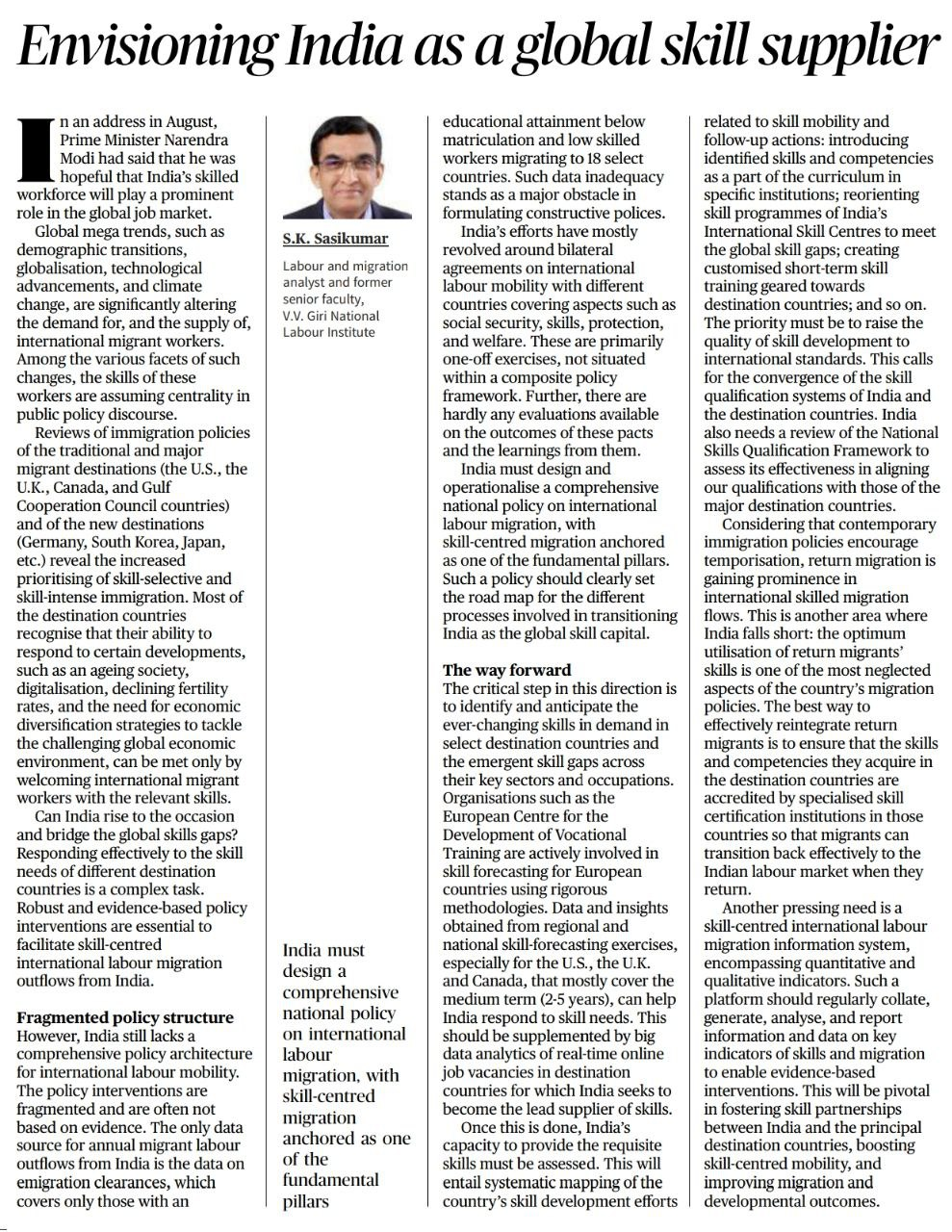1. Administrative Reforms in India: Challenges and the Way Forward
Introduction
The Indian Administrative Service (IAS), often termed the “steel frame” of India’s governance, has played a pivotal role in shaping the nation’s post-Independence trajectory. However, persistent challenges such as politicization, lack of specialization, and bureaucratic inefficiency highlight the urgent need for reforms. Addressing these issues is essential for unleashing India’s full governance and economic potential.
Legacy and Challenges of the IAS
- Historical Background
- The IAS evolved from the colonial Indian Civil Service (ICS) post-Independence.
- It became the backbone of India’s administrative machinery, ensuring continuity in governance.
- Current Challenges
- Politicization: Transfers and promotions influenced by political interests undermine meritocracy and professionalism.
- Lack of Specialization: Frequent cadre rotations hinder domain expertise in critical sectors.
- Bureaucratic Inefficiency: As per the World Bank, India’s governance effectiveness is moderate, with poor implementation of policies and administrative bottlenecks.
- Accountability Issues: Centralization of power in bodies like the Prime Minister’s Office (PMO) reduces autonomy and decision-making capacity at senior levels.
Government Efforts for Reform
- Lateral Entry Initiative
- Aimed at diversifying governance by inducting private-sector professionals into bureaucratic positions.
- However, its implementation remains limited, with only 33% of proposed posts filled.
- Second Administrative Reforms Commission (ARC)
- Recommended measures like:
- Merit-based promotions.
- Accountability safeguards to prevent arbitrary decisions.
- Many recommendations remain unimplemented due to bureaucratic inertia and political resistance.
- Recommended measures like:
International Perspectives
- S. Department of Government Efficiency (DOGE):
- Focuses on specialized recruitment, performance assessments, and accountability mechanisms.
- Offers insights for reforming India’s administrative apparatus.
Challenges to Reform
- Resistance to Change
- Specialized training for bureaucrats faces opposition from within the system.
- Institutionalized political interference hinders implementation of reforms.
- Judicial Interventions
- Efforts like establishing Civil Services Boards in 2013 have had limited impact due to lack of enforcement.
Conclusion
The IAS’s role as the backbone of governance underscores its importance in India’s development. However, addressing systemic inefficiencies and ensuring meritocracy, specialization, and accountability are critical. A robust framework of administrative reforms, drawing lessons from global best practices, is essential for empowering the bureaucracy and realizing India’s governance potential.
Mains Practice Question |
Q. Examine the key challenges facing the Indian Administrative Service (IAS) in the current governance framework. Discuss the reforms needed to enhance its efficiency, accountability, and role in India’s development. |
2. The GATT-ification of the WTO: Implications for Global Trade Governance
Introduction
The World Trade Organization (WTO), established in 1995 as a successor to the General Agreement on Tariffs and Trade (GATT), promised a comprehensive, rule-based system to govern global trade. However, the persistent U.S. blockade of the Appellate Body, a critical component of the WTO’s dispute settlement mechanism, has rendered the institution dysfunctional. This development signals a potential regression to the GATT era, characterized by diplomacy-driven trade relations.
The Evolution of the WTO
- From GATT to WTO
- GATT (1948–1994): Focused on tariff reductions through diplomacy.
- WTO (1995): Marked the shift to a legalistic and rules-based system with binding dispute resolution mechanisms.
- Key Features of the WTO
- Comprehensive regulation of goods, services, and intellectual property.
- Binding two-tier dispute settlement system:
- Panel for initial adjudication.
- Appellate Body (AB) for review and final resolution.
Challenges Facing the WTO
- Crisis of the Appellate Body
- S. Obstruction:
- Began under Obama, escalated during Trump, and continued under Biden.
- Refusal to appoint AB members has made the system non-operational.
- S. Obstruction:
- Implications:
- WTO’s promise of rule-based dispute resolution is undermined.
- Countries increasingly adopt unilateral trade measures.
- Shift in Global Trade Dynamics
- China’s Rise:
- S. supported China’s WTO accession in 2001, expecting liberalization.
- China’s state-led trade policies have since challenged WTO principles.
- China’s Rise:
- Protectionism:
- Trump administration imposed tariffs on Chinese goods (2018), violating WTO norms.
- Indicates a shift to bilateralism over multilateral trade governance.
- Erosion of Rule-Based Multilateralism
- Scholars describe this shift as the “GATT-ification” of the WTO.
- Focus shifts from rules to power politics, diluting legal obligations.
Global Implications
- Regime Change in International Trade
- Legal trade multilateralism is being replaced by state-controlled diplomacy.
- Reclamation of sovereignty by member states marks a return to pre-WTO dynamics.
- Thinning of Legality
- Rule-based enforcement mechanisms are weakening.
- A potential breakdown of WTO’s legal framework is feared.
Conclusion
The WTO’s decline signifies a profound crisis in global trade governance. As rule-based multilateralism gives way to power-driven bilateralism, the international trading system risks fragmentation. Reviving the Appellate Body and reinforcing institutional mechanisms are critical to preserving the WTO’s relevance in the evolving global order.
Mains Practice Question |
Q. “The WTO is witnessing a regression to the GATT era in global trade governance.” Critically analyze the challenges faced by the WTO and suggest measures to address its current crisis. |
3. India as a Global Skill Supplier: Opportunities and Challenges
Introduction
India’s vast skilled workforce, coupled with demographic advantages, places it in a unique position to meet the rising global demand for skilled labor. However, a fragmented policy framework and limited focus on skill-centered international labor migration pose significant challenges. Bridging global skill gaps requires robust, evidence-based policy interventions to transform India into a global skill hub.
Global Trends in Labor Mobility
- Demand Drivers
- Demographic transitions in developed nations.
- Advancements in technology and climate change influencing labor markets.
- Sectors such as healthcare, digital services, and renewable energy showing heightened demand for skilled workers.
- Destination Country Policies
- Traditional destinations: U.S., U.K., Canada, and Gulf Cooperation Council (GCC) countries.
- Emerging destinations: Germany, Japan, and South Korea.
- Common trends:
- Focus on skill-selective migration policies.
- Need for workers who can adapt to evolving economic and demographic conditions.
Challenges in India’s Skill-Centered Migration
- Fragmented Policy Framework
- Lack of a comprehensive national policy on international labor migration.
- Reliance on limited data such as annual labor outflows without a broader understanding of skill gaps.
- Inadequate Skill Matching
- Majority of Indian migrant workers fall below matriculation levels.
- Poor alignment of training programs with the skill demands of destination countries.
- One-Off Agreements
- Bilateral labor mobility agreements often lack an integrated approach.
- Minimal evaluation mechanisms to measure their impact.
Policy Recommendations
- Comprehensive National Policy
- Anchor labor migration in skill-centered migration strategies.
- Focus on creating a robust institutional framework to streamline migration processes.
- Skill-Training Alignment
- Customized skill training programs aligned with the demands of key destination countries.
- Expansion of International Skill Centers to address global skill gaps.
- Regional and National Skill Forecasting
- Collaboration with organizations like the European Centre for the Development of Vocational Training.
- Utilize real-time labor market data to guide training efforts.
- Reintegration Programs
- Ensure returning migrants transition effectively into the domestic labor market.
- Accreditation and certification of acquired skills to enable seamless reintegration.
Conclusion
India’s demographic dividend and growing skill base offer immense potential to position itself as a global skill supplier. A cohesive, evidence-based approach to skill-centered international labor migration, supported by robust data and bilateral cooperation, can address existing gaps and foster sustainable migration. Transforming policy aspirations into actionable strategies is key to realizing India’s role in the global workforce.
Mains Practice Question |
Q. Discuss the challenges faced by India in becoming a global supplier of skilled labor. Suggest measures to create a skill-centered framework for international labor migration. |




